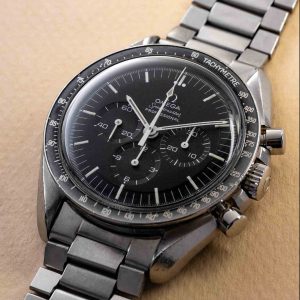Rolex Day-Date 1800 series

A story about Rolex Day-Date watches. We are proud to show you a magnificent collection of Rolex Day-Date models we currently have in-store.

By AWCo on 8 July 2017
Amsterdam Watch Company is proud to show you a magnificent collection of Rolex Day-Date models we currently have in-store. A nice opportunity to look deeper into this ‘presidential’ model and especially the 1800 series. This so-called “four digits” reference Rolex Day-Date is made until 1977 and is recognizable by the non-quick set day & date function and the Plexiglass crystal.
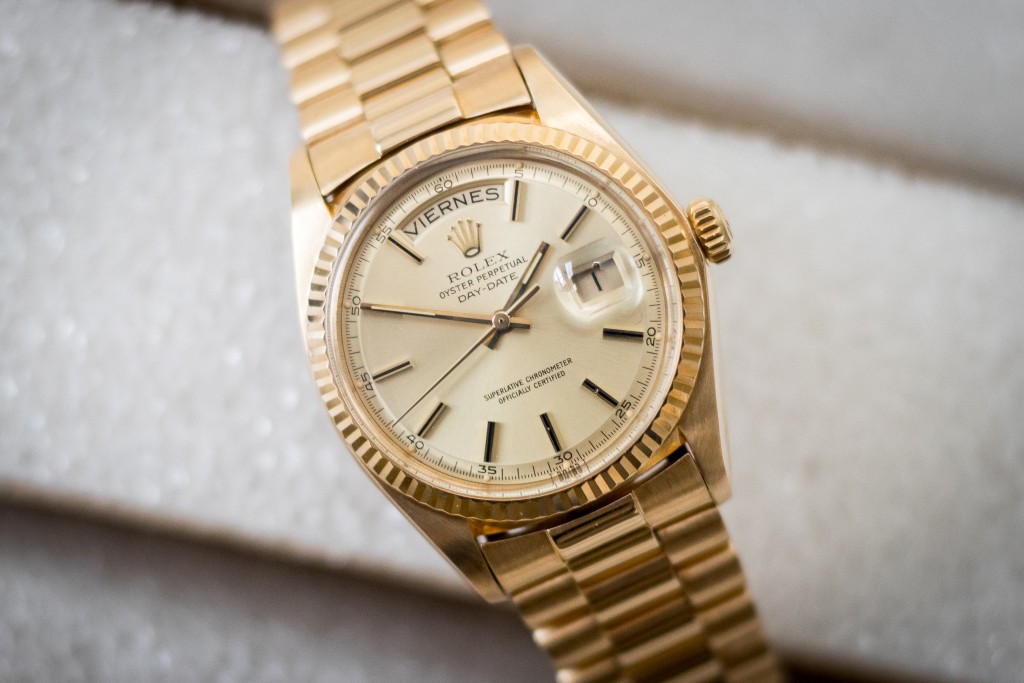
The Rolex Day-Date
It wasn’t until 1956 and the introduction of the Day-Date that Rolex produced a complicated watch which really resonated with the public. Rolex has produced very complicated watches in their past, but they just didn’t sell particularly well for Rolex.
The Day-Date featured a window at the 12 o’clock position displayed the day of the week, which synched perfectly with the day of the month window at 3 o’clock. The Day-Date also featured a brand new ‘President’ bracelet, although the Day-Date didn’t become (unofficially) known as the ‘President’ until a Day-Date was given to US President Dwight Eisenhower by Rolex. The day of the week wheel can be ordered in 26 different languages. The Day-Date is available in the following precious metals: yellow gold, white gold, rose gold and platinum.
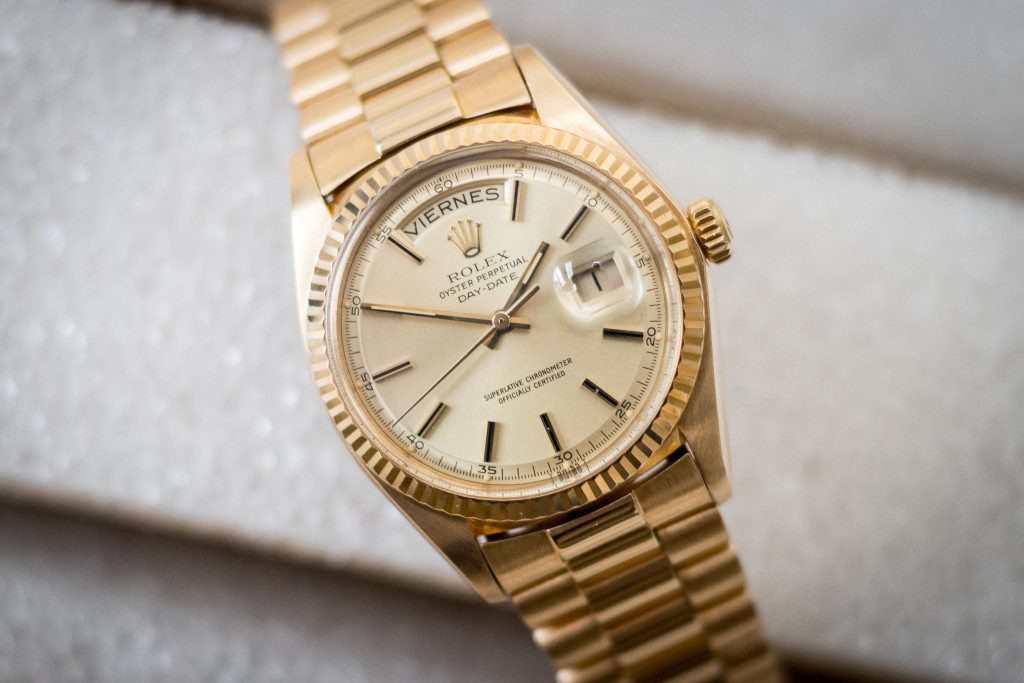
The precision of this watch comes from the famous Valjoux 72 movement. This movement was introduced in 1938 and this reliable and loved workhorse has been produced over 750.000 times when it’s production came to an end in 1974. Rolex even used this manual movement to power their early Daytona’s! A nice detail about this movement was the new ‘column wheel’, a new wheel in the chronograph function protecting the other wheels around it from wear of damage. You’ll need a sharp eye for it, but a fun gimmick about this much-appreciated movement is the distance between the pushers and the crown. On this watch, the distance between the top-pusher and the crown is smaller than the distance between the bottom pusher and the crown. Jack Heuer was a fan of this Valjoux 72 movement as well eventually using it in the early Carrera’s and Autavia’s.
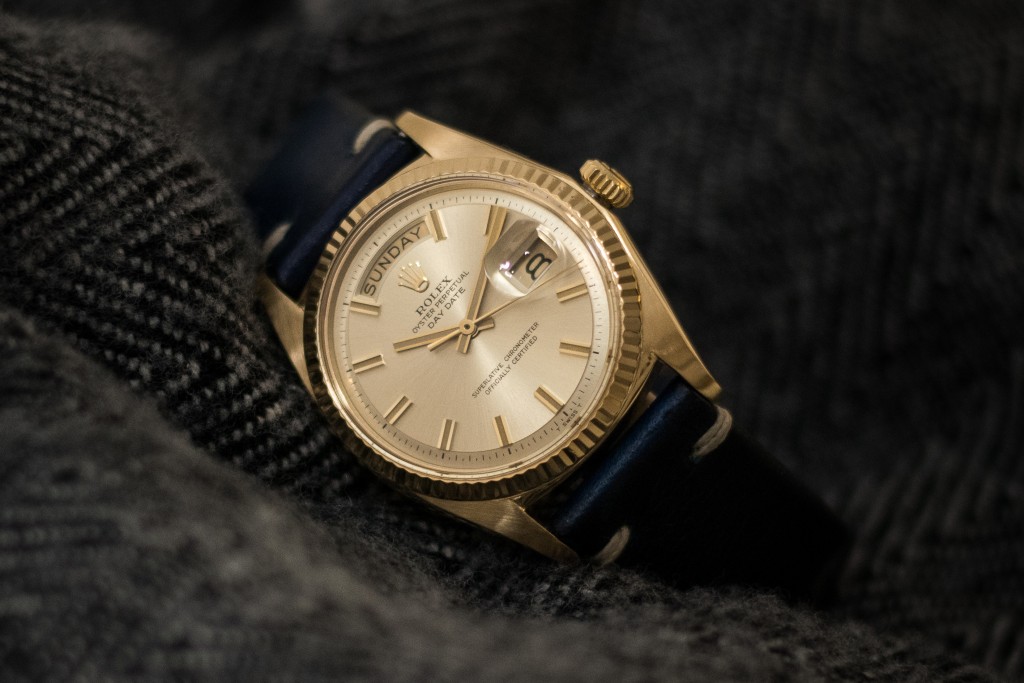
Day-Date 1800 series
The reference 1803 first appeared in a Rolex catalog in 1961, together with the reference 1804 and 1806. The reference 1802 and 1807 appeared in 1963 and the last Day-Date of the series 1800, the reference 1811, appeared in 1966.
Interesting note: in the 1973 Rolex spare parts catalog, some references of the Day-Date appear which have never been seen on the international market: 1805, 1808, 1809, 1810, 1812 and 1814. The reference 1831 has never appeared in any Rolex catalog: a Day-Date in platinum, in which only 8 examples were made, following a special order.
After de 1800 series Rolex introduced the 18000 series.
Rolex wanted to improve the sealing of the three weak points of a watch: the crystal, the case back and the winding crown. In 1977 the Day-Date got improved by a guaranteed waterproof to a depth of 100 meters (instead of 50 meters for the 1800 series), a transition from Plexiglas crystal to sapphire crystal, a creation of a new caliber 3055 and a single quickset of the date (at the end of the 80’s Rolex introduced a double quickset of day and date).
Now, back to the 1800 series. It is interesting to note that the references to the 1800 series do not indicate the material but exclusively the type of bezel. Hereby following the characteristic bezels of the different references:
- 1802: polished or smooth bezel (quite rare)
- 1803: reeded or fluted bezel (most common)
- 1804: diamond set bezel
- 1806: Florentine finish
- 1807: bark effect
- 1811: engraved (Morrelis or Moire finish) (quite rare)

The dial style, rarity, and condition.
I aThe reference 1803 is probably the most common and sold reference of the 1800 series. As mentioned this reference was made in four types of precious metals. Our guess would be that maybe 70% was made and sold in yellow gold. The remaining percentage was produced and sold in rose gold, white gold or platinum.
Another specific characteristic of the 1800 series is that all the dials have a flared external edge and it is for this reason that they are called ‘pie-pan’ by collectors. This was only possible by using the caliber 1500 movement. With these watches, the date function could not be quickly set. This movement was also a little bit ‘spherical’. As a result, the dials could be made slightly downwards as well. Up to the date disc diameter, the dial is straight and from that point, there was room for a ‘facet’ in the dial. This particular feature gives the watch a distinctive vintage look that is so popular with collectors.

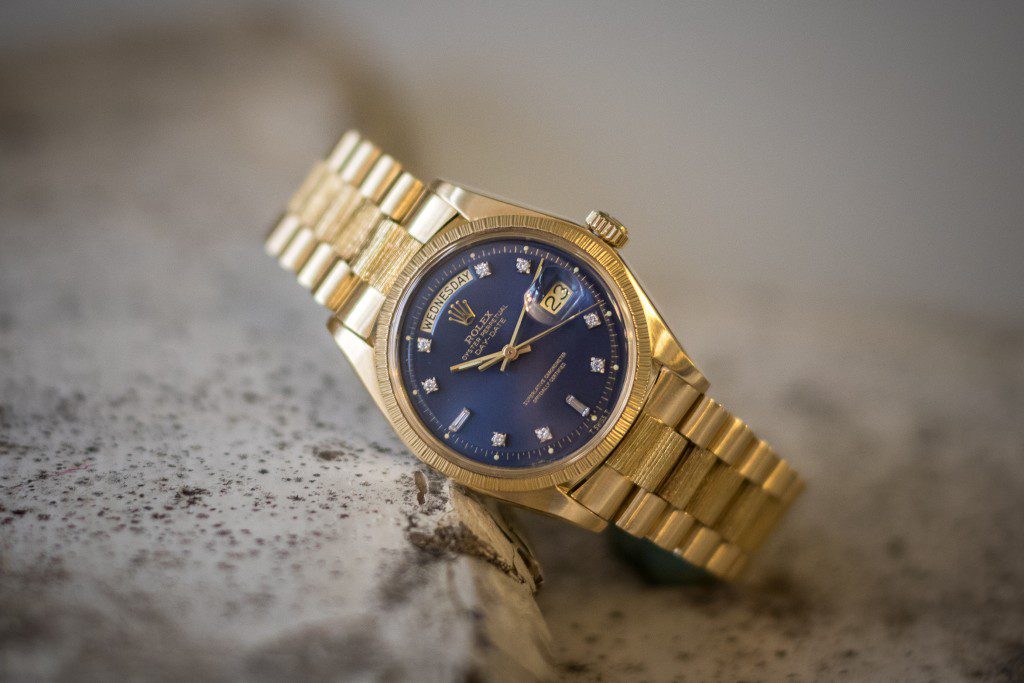
There is a wide choice of dials.
There is a wide choice of dials which range from classic models, like the classic gold “champagne” color, to the most suggestive and fashionable colored dials. Rarer are the colors silver, blue and black. Next, to these colors, there weren’t any other available, except for the so-called “Stella dial”. We mentioned this type of dial in a previous topic.
Then there is another variation in the structure of the dial, like ‘linen’. It’s possible to date a specific model by the variation of the dial. Because some variations were made in certain time periods. Knowing this, finding a specific variation can be quite interesting and not easy to find.
More important than the color is the condition of the dial. A small scratch does not have to be a big issue, but the general state must be good and fresh. In particular, look at the discoloration of the protective layer. Each dial has a layer to protect the dial (color) from oxygen and moisture. This layer may become ‘mucky’ brownish or flattery. Some people think this is how it’s supposed to be. If it happens evenly, we can appreciate it. But if not, it will affect the quality and therefore the value.
For quite a while we have noticed that there is a lot of interest in this iconic Rolex model. The king of the Oyster is not only worn by the leaders of the world and captains of the industry anymore. We welcome more and more watch lovers and a whole new generation of young people who appreciate this Rolex model.


